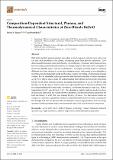| dc.contributor.author | Talwar, Devki N. | |
| dc.contributor.author | Becla, Piotr | |
| dc.date.accessioned | 2025-07-11T21:00:33Z | |
| dc.date.available | 2025-07-11T21:00:33Z | |
| dc.date.issued | 2025-07-01 | |
| dc.identifier.uri | https://hdl.handle.net/1721.1/160034 | |
| dc.description.abstract | first_pagesettingsOrder Article Reprints
Open AccessArticle
Composition-Dependent Structural, Phonon, and Thermodynamical Characteristics of Zinc-Blende BeZnO
by Devki N. Talwar 1,2,*ORCID andPiotr Becla 3
1
Department of Physics, University of North Florida, 1 UNF Drive, Jacksonville, FL 32224, USA
2
Department of Physics, Indiana University of Pennsylvania, 975 Oakland Avenue, 56 Weyandt Hall, Indiana, PA 15705, USA
3
Department of Materials Science and Engineering, Massachusetts Institute of Technology, Cambridge, MA 02139, USA
*
Author to whom correspondence should be addressed.
Materials 2025, 18(13), 3101; https://doi.org/10.3390/ma18133101
Submission received: 16 May 2025 / Revised: 9 June 2025 / Accepted: 16 June 2025 / Published: 1 July 2025
(This article belongs to the Special Issue Advanced Additive Manufacturing Processing of Ceramic Materials)
Downloadkeyboard_arrow_down Browse Figures Versions Notes
Abstract
Both ZnO and BeO semiconductors crystallize in the hexagonal wurtzite (wz), cubic rock salt (rs), and zinc-blende (zb) phases, depending upon their growth conditions. Low-dimensional heterostructures ZnO/BexZn1-xO and BexZn1-xO ternary alloy-based devices have recently gained substantial interest to design/improve the operations of highly efficient and flexible nano- and micro-electronics. Attempts are being made to engineer different electronic devices to cover light emission over a wide range of wavelengths to meet the growing industrial needs in photonics, energy harvesting, and biomedical applications. For zb materials, both experimental and theoretical studies of lattice dynamics ωj(q→)
have played crucial roles for understanding their optical and electronic properties. Except for zb ZnO, inelastic neutron scattering measurement of ωj(q→)
for BeO is still lacking. For the BexZn1-xO ternary alloys, no experimental and/or theoretical studies exist for comprehending their structural, vibrational, and thermodynamical traits (e.g., Debye temperature ΘD(T);
specific heat Cv(T))
. By adopting a realistic rigid-ion model, we have meticulously simulated the results of lattice dynamics, and thermodynamic properties for both the binary zb ZnO, BeO and ternary BexZn1-xO alloys. The theoretical results are compared/contrasted against the limited experimental data and/or ab initio calculations. We strongly feel that the phonon/thermodynamic features reported here will encourage spectroscopists to perform similar measurements and check our theoretical conjectures. | en_US |
| dc.publisher | Multidisciplinary Digital Publishing Institute | en_US |
| dc.relation.isversionof | http://dx.doi.org/10.3390/ma18133101 | en_US |
| dc.rights | Creative Commons Attribution | en_US |
| dc.rights.uri | https://creativecommons.org/licenses/by/4.0/ | en_US |
| dc.source | Multidisciplinary Digital Publishing Institute | en_US |
| dc.title | Composition-Dependent Structural, Phonon, and Thermodynamical Characteristics of Zinc-Blende BeZnO | en_US |
| dc.type | Article | en_US |
| dc.identifier.citation | Talwar, D.N.; Becla, P. Composition-Dependent Structural, Phonon, and Thermodynamical Characteristics of Zinc-Blende BeZnO. Materials 2025, 18, 3101. | en_US |
| dc.contributor.department | Massachusetts Institute of Technology. Department of Materials Science and Engineering | en_US |
| dc.relation.journal | Materials | en_US |
| dc.identifier.mitlicense | PUBLISHER_CC | |
| dc.eprint.version | Final published version | en_US |
| dc.type.uri | http://purl.org/eprint/type/JournalArticle | en_US |
| eprint.status | http://purl.org/eprint/status/PeerReviewed | en_US |
| dc.date.updated | 2025-07-11T14:34:49Z | |
| dspace.date.submission | 2025-07-11T14:34:49Z | |
| mit.journal.volume | 18 | en_US |
| mit.journal.issue | 13 | en_US |
| mit.license | PUBLISHER_CC | |
| mit.metadata.status | Authority Work and Publication Information Needed | en_US |
